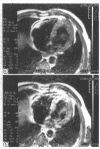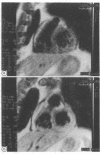Abstract
The diagnostic value of gadolinium-DTPA (diethylenetriamine penta-acetic acid) enhanced magnetic resonance imaging in patients treated by thrombolysis for acute myocardial infarction was assessed in 27 consecutive patients who had a first acute myocardial infarction (14 anterior, 13 inferior) and who underwent thrombolytic treatment and coronary arteriography within 4 hours of the onset of symptoms. Magnetic resonance imaging was performed 93 hours (range 15-241) after the onset of symptoms. A Philips Gyroscan (0.5 T) was used, and spin echo measurements (echo time 30 ms) were made before and 20 minutes after intravenous injection of 0.1 mmol/kg gadolinium-DTPA. In all patients contrast enhancement of the infarcted areas was seen after Gd-DTPA. The signal intensities of the infarcted and normal values were used to calculate the intensity ratios. Mean (SD) intensity ratios after Gd-DTPA were significantly increased (1.15 (0.17) v 1.52 (0.29). Intensity ratios were higher in the 17 patients who underwent magnetic resonance imaging more than 72 hours after the onset of symptoms than in the 10 who underwent magnetic resonance imaging earlier, the difference being significantly greater after administration of Gd-DTPA (1.38 (0.12) v 1.61 (0.34). When patients were classified according to the site and size of the infarcted areas, or to reperfusion (n = 19) versus non-reperfusion (n = 8), the intensity ratios both before and after Gd-DTPA did not show significant differences. Magnetic resonance imaging with Gd-DTPA improved the identification of acutely infarcted areas, but with current techniques did not identify patients in whom thrombolytic treatment was successful.
Full text
PDF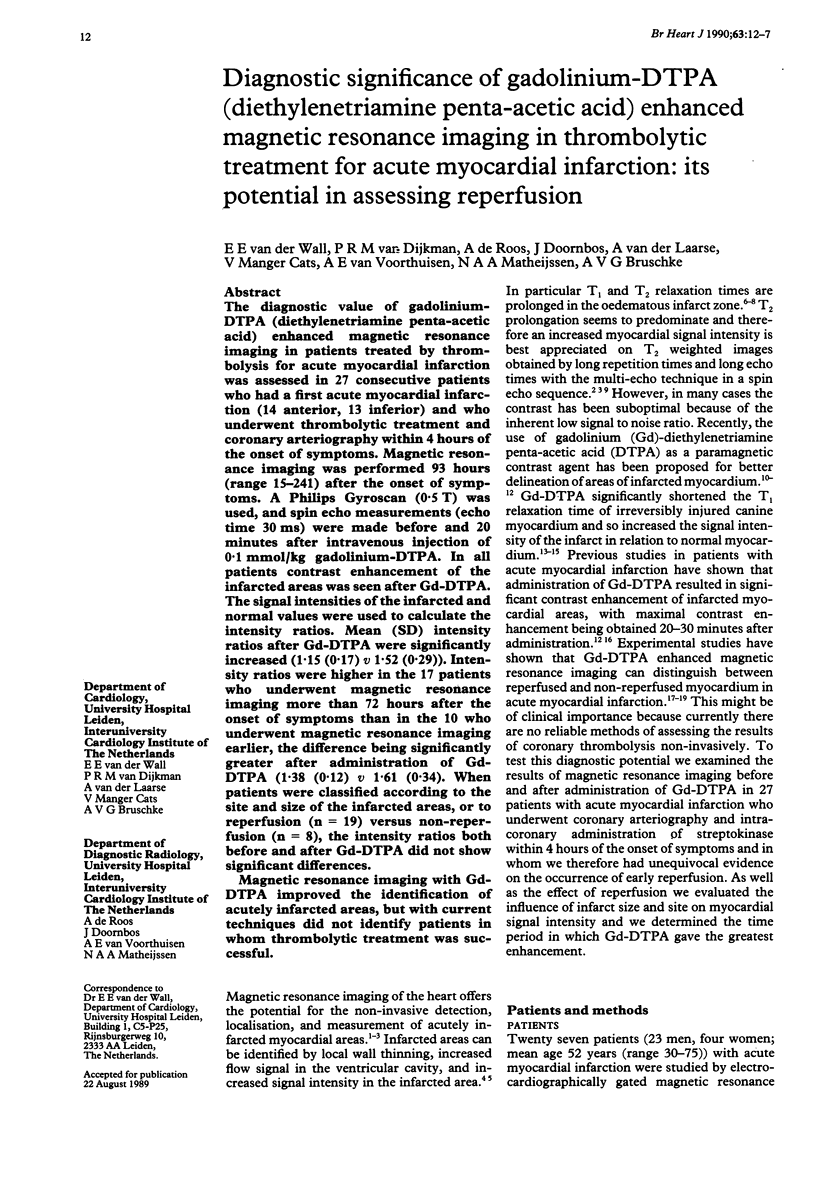
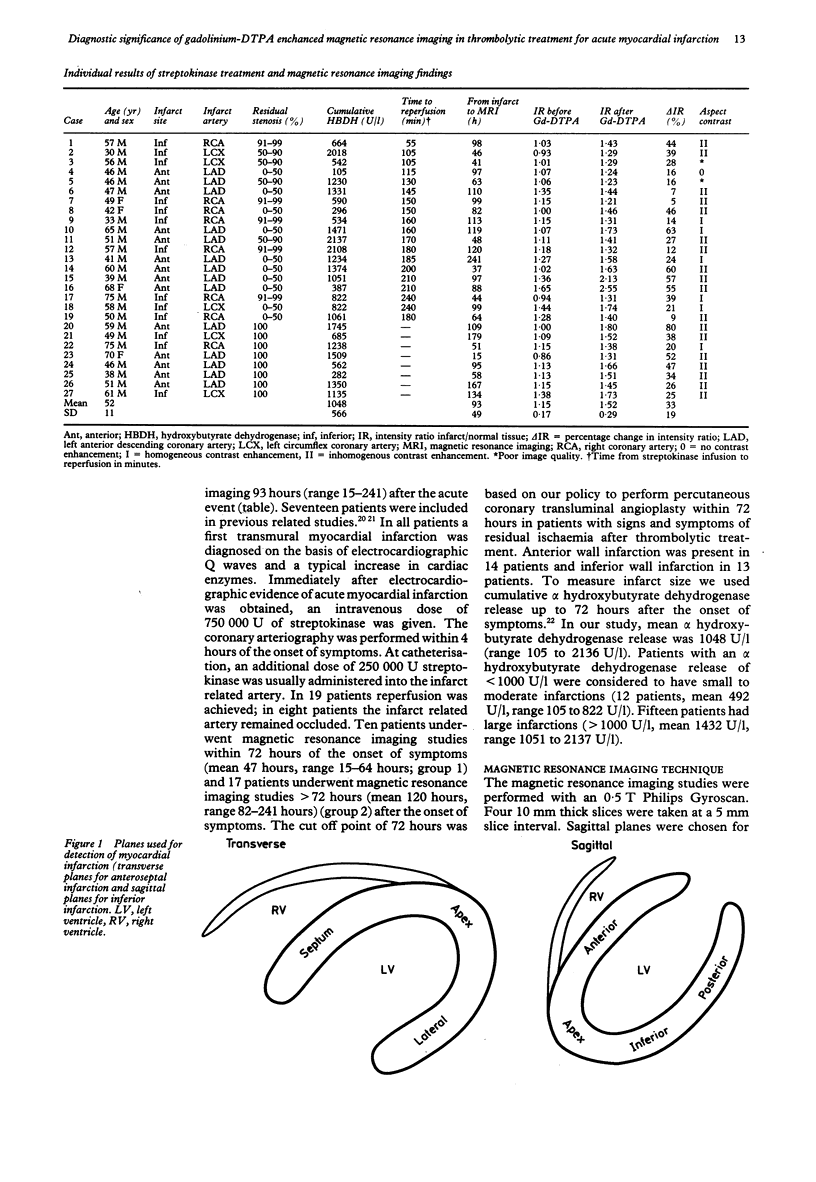

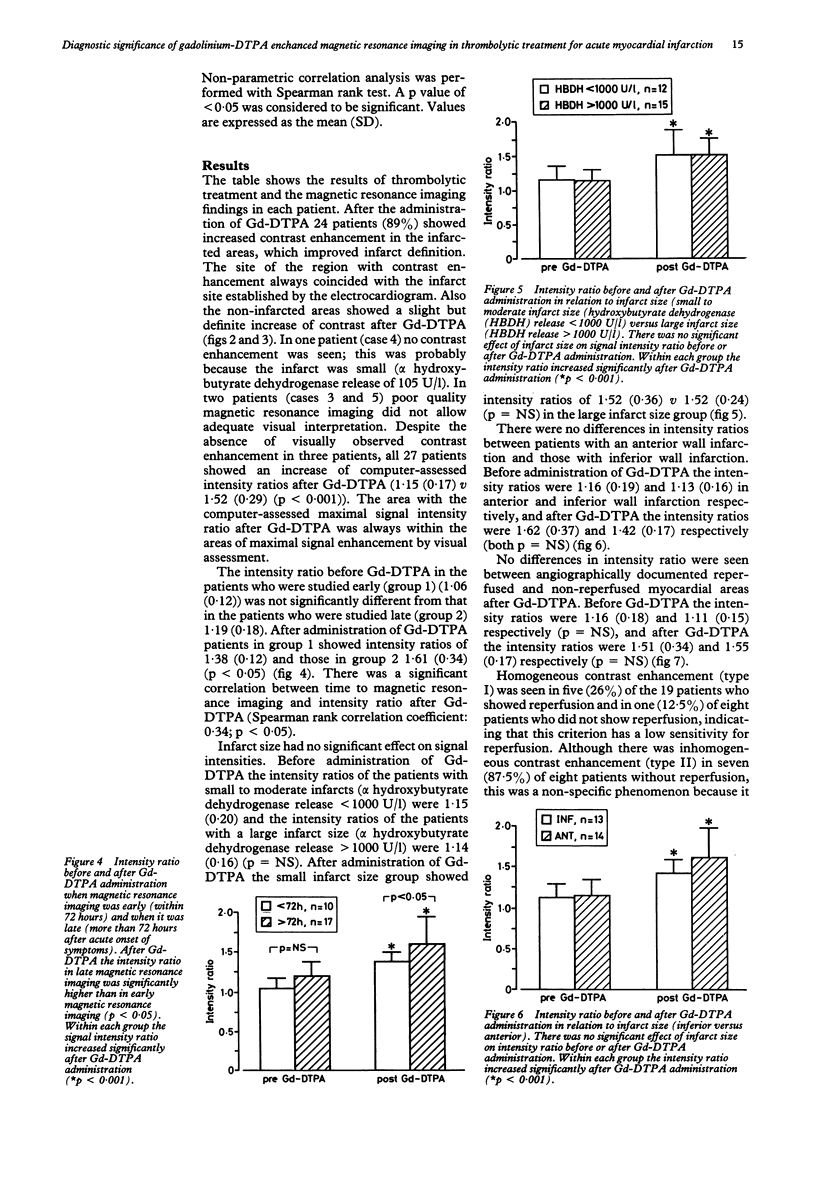

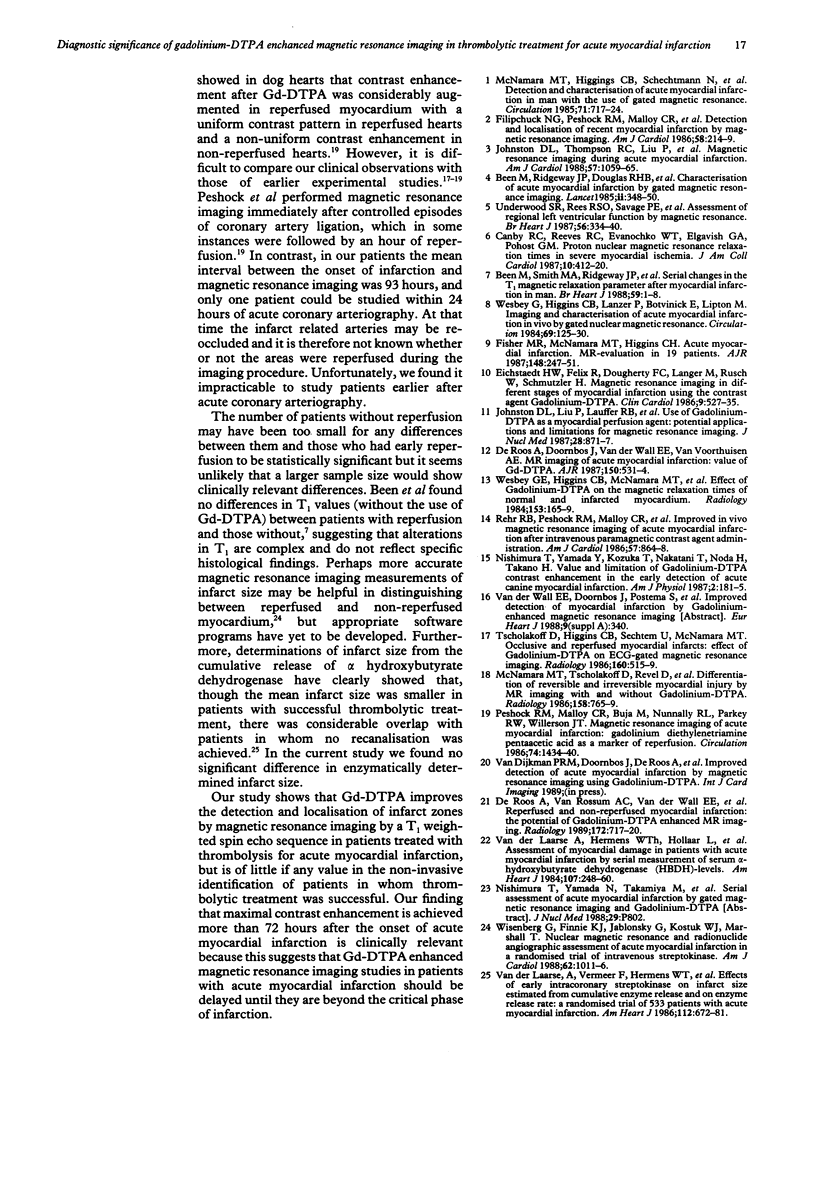
Images in this article
Selected References
These references are in PubMed. This may not be the complete list of references from this article.
- Been M., Smith M. A., Ridgway J. P., Douglas R. H., de Bono D. P., Best J. J., Muir A. L. Serial changes in the T1 magnetic relaxation parameter after myocardial infarction in man. Br Heart J. 1988 Jan;59(1):1–8. doi: 10.1136/hrt.59.1.1. [DOI] [PMC free article] [PubMed] [Google Scholar]
- Canby R. C., Reeves R. C., Evanochko W. T., Elgavish G. A., Pohost G. M. Proton nuclear magnetic resonance relaxation times in severe myocardial ischemia. J Am Coll Cardiol. 1987 Aug;10(2):412–420. doi: 10.1016/s0735-1097(87)80026-8. [DOI] [PubMed] [Google Scholar]
- Eichstaedt H. W., Felix R., Dougherty F. C., Langer M., Rutsch W., Schmutzler H. Magnetic resonance imaging (MRI) in different stages of myocardial infarction using the contrast agent gadolinium-DTPA. Clin Cardiol. 1986 Nov;9(11):527–535. doi: 10.1002/clc.4960091102. [DOI] [PubMed] [Google Scholar]
- Filipchuk N. G., Peshock R. M., Malloy C. R., Corbett J. R., Rehr R. B., Buja L. M., Jansen D. E., Redish G. R., Gabliani G. I., Parkey R. W. Detection and localization of recent myocardial infarction by magnetic resonance imaging. Am J Cardiol. 1986 Aug 1;58(3):214–219. doi: 10.1016/0002-9149(86)90049-4. [DOI] [PubMed] [Google Scholar]
- Fisher M. R., McNamara M. T., Higgins C. B. Acute myocardial infarction: MR evaluation in 29 patients. AJR Am J Roentgenol. 1987 Feb;148(2):247–251. doi: 10.2214/ajr.148.2.247. [DOI] [PubMed] [Google Scholar]
- Johnston D. L., Liu P., Lauffer R. B., Newell J. B., Wedeen V. J., Rosen B. R., Brady T. J., Okada R. D. Use of gadolinium-DTPA as a myocardial perfusion agent: potential applications and limitations for magnetic resonance imaging. J Nucl Med. 1987 May;28(5):871–877. [PubMed] [Google Scholar]
- Johnston D. L., Thompson R. C., Liu P., Dinsmore R. E., Wismer G. L., Saini S., Kaul S., Rosen B. R., Brady T. J., Okada R. D. Magnetic resonance imaging during acute myocardial infarction. Am J Cardiol. 1986 May 1;57(13):1059–1065. doi: 10.1016/0002-9149(86)90674-0. [DOI] [PubMed] [Google Scholar]
- McNamara M. T., Higgins C. B., Schechtmann N., Botvinick E., Lipton M. J., Chatterjee K., Amparo E. G. Detection and characterization of acute myocardial infarction in man with use of gated magnetic resonance. Circulation. 1985 Apr;71(4):717–724. doi: 10.1161/01.cir.71.4.717. [DOI] [PubMed] [Google Scholar]
- McNamara M. T., Tscholakoff D., Revel D., Soulen R., Schechtmann N., Botvinick E., Higgins C. B. Differentiation of reversible and irreversible myocardial injury by MR imaging with and without gadolinium-DTPA. Radiology. 1986 Mar;158(3):765–769. doi: 10.1148/radiology.158.3.3945751. [DOI] [PubMed] [Google Scholar]
- Nishimura T., Yamada Y., Kozuka T., Nakatani T., Noda H., Takano H. Value and limitation of gadolinium-DTPA contrast enhancement in the early detection of acute canine myocardial infarction. Am J Physiol Imaging. 1987;2(4):181–185. [PubMed] [Google Scholar]
- Peshock R. M., Malloy C. R., Buja L. M., Nunnally R. L., Parkey R. W., Willerson J. T. Magnetic resonance imaging of acute myocardial infarction: gadolinium diethylenetriamine pentaacetic acid as a marker of reperfusion. Circulation. 1986 Dec;74(6):1434–1440. doi: 10.1161/01.cir.74.6.1434. [DOI] [PubMed] [Google Scholar]
- Rehr R. B., Peshock R. M., Malloy C. R., Keller A. M., Parkey R. W., Buja L. M., Nunnally R. L., Willerson J. T. Improved in vivo magnetic resonance imaging of acute myocardial infarction after intravenous paramagnetic contrast agent administration. Am J Cardiol. 1986 Apr 1;57(10):864–868. doi: 10.1016/0002-9149(86)90628-4. [DOI] [PubMed] [Google Scholar]
- Tscholakoff D., Higgins C. B., Sechtem U., McNamara M. T. Occlusive and reperfused myocardial infarcts: effect of Gd-DTPA on ECG-gated MR imaging. Radiology. 1986 Aug;160(2):515–519. doi: 10.1148/radiology.160.2.3726135. [DOI] [PubMed] [Google Scholar]
- Wesbey G. E., Higgins C. B., McNamara M. T., Engelstad B. L., Lipton M. J., Sievers R., Ehman R. L., Lovin J., Brasch R. C. Effect of gadolinium-DTPA on the magnetic relaxation times of normal and infarcted myocardium. Radiology. 1984 Oct;153(1):165–169. doi: 10.1148/radiology.153.1.6473778. [DOI] [PubMed] [Google Scholar]
- Wesbey G., Higgins C. B., Lanzer P., Botvinick E., Lipton M. J. Imaging and characterization of acute myocardial infarction in vivo by gated nuclear magnetic resonance. Circulation. 1984 Jan;69(1):125–130. doi: 10.1161/01.cir.69.1.125. [DOI] [PubMed] [Google Scholar]
- Wisenberg G., Finnie K. J., Jablonsky G., Kostuk W. J., Marshall T. Nuclear magnetic resonance and radionuclide angiographic assessment of acute myocardial infarction in a randomized trial of intravenous streptokinase. Am J Cardiol. 1988 Nov 15;62(16):1011–1016. doi: 10.1016/0002-9149(88)90539-5. [DOI] [PubMed] [Google Scholar]
- de Roos A., Doornbos J., van der Wall E. E., van Voorthuisen A. E. MR imaging of acute myocardial infarction: value of Gd-DTPA. AJR Am J Roentgenol. 1988 Mar;150(3):531–534. doi: 10.2214/ajr.150.3.531. [DOI] [PubMed] [Google Scholar]
- de Roos A., van Rossum A. C., van der Wall E., Postema S., Doornbos J., Matheijssen N., van Dijkman P. R., Visser F. C., van Voorthuisen A. E. Reperfused and nonreperfused myocardial infarction: diagnostic potential of Gd-DTPA--enhanced MR imaging. Radiology. 1989 Sep;172(3):717–720. doi: 10.1148/radiology.172.3.2772179. [DOI] [PubMed] [Google Scholar]
- van der Laarse A., Hermens W. T., Hollaar L., Jol M., Willems G. M., Lemmers H. E., Liem A. H., Souverijn J. H., Oudhof J. H., de Hooge J. Assessment of myocardial damage in patients with acute myocardial infarction by serial measurement of serum alpha-hydroxybutyrate dehydrogenase levels. Am Heart J. 1984 Feb;107(2):248–260. doi: 10.1016/0002-8703(84)90372-7. [DOI] [PubMed] [Google Scholar]
- van der Laarse A., Vermeer F., Hermens W. T., Willems G. M., de Neef K., Simoons M. L., Serruys P. W., Res J., Verheugt F. W., Krauss X. H. Effects of early intracoronary streptokinase on infarct size estimated from cumulative enzyme release and on enzyme release rate: a randomized trial of 533 patients with acute myocardial infarction. Am Heart J. 1986 Oct;112(4):672–681. doi: 10.1016/0002-8703(86)90460-6. [DOI] [PubMed] [Google Scholar]



